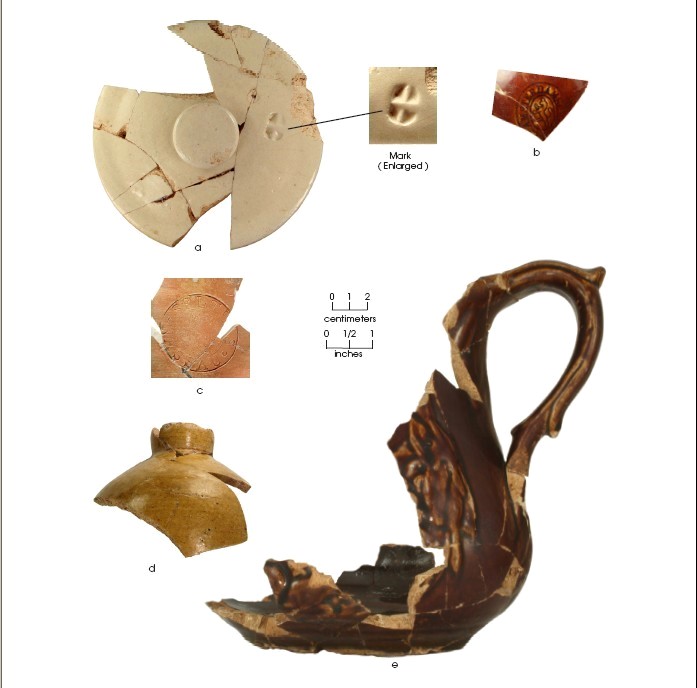
Some of the stoneware vessels in the Williams farmstead collection have unique identifying marks. Four of the vessels with marks are shown in this image: (a) a wide-mouth jar lid with an impressed mark on its surface resembling a cross (an X inside an oval); (b) a mineral water bottle with a stamped mark-a small oval enclosing a lion with the word "AMSTERDAMSCHE" above the lion. The contents of this bottle are not known, but it is suspected that it originally contained some form of mineral water, seltzer, soda water, or beer. Item (c) is a stoneware bottle fragment with the mark of "SELTERS / NASSAU" with an eagle and crown. The mark indicates that this bottle originally contained some type of mineral water and was imported from Germany. Item (d) is a stoneware jar neck and mouth. The vessel was used to contain liquids. This particular specimen does not have any diagnostic markings. Item (e) is an example of a Rockingham pitcher with a long loop handle. Such vessels typically were a brown-slipped yellowware that depicted some type of nature scene such as hunting or wildlife. The design on this vessel is too fragmented to tell what was depicted.
The mark on the jar lid of specimen (a) is an X integrated inside an oval, and it has not been identified to any particular pottery or place. But it is interesting to note how similar this Oval-X mark is to the "Landrum Cross" marks used by many African American potters working in the Edgefield District of South Carolina. The Edgefield District was the birthplace of the southern alkaline-glazed stoneware tradition, and some of the African American potters who ended up in Texas came from South Carolina, such as the Wilson brothers who founded their own pottery businesses in Guadalupe County after emancipation. Simple cross marks have been found on many African American-made colonowares (earthenwares) in the Southern United States, and one of the Edgefield District's most famous black potters, Dave Drake, inscribed some of the vessels he produced with an "X."
This tradition became widespread, and the circle-and-cross symbol that became known as the Landrum Cross was often used on stonewares produced in the Edgefield District and into Georgia. The Landrum Cross may be a variant of a cosmogram symbol-a cross in a circle that represented world cosmology for many West African cultures. While we cannot conclude that the X-circle mark on item (a) means that this item was made by African American potters, the mark's similarity to some of the Edgefield marks and cosmogram imagery is tantalizing nonetheless. If the Oval-X mark on this item was made by a black potter, whether an enslaved worker or a freedman, it would represent a continued use of cultural identify mark that has deep roots in the South. NOTE: Similar Landrum Cross marks are illustrated in a 2011 article by J. W. Joseph in the Society for Historical Archeology journal, Historical Archaeology.